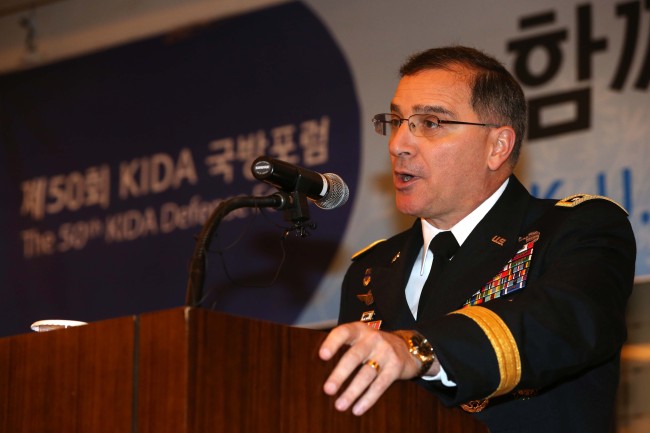U.S. Forces Korea Commander Gen. Curtis Scaparrotti confirmed Tuesday that Washington was considering deploying an advanced missile defense system to South Korea to better deal with “evolving” missile threats from North Korea.
During a forum in Seoul, the commander said that he had recommended that the U.S. consider sending the Terminal High-Altitude Area Defense system, one of the core assets of the multi-layered U.S. MD program, to the peninsula.
“There was consideration being taken in order to consider the THAAD being deployed here in Korea. It was a U.S. initiative. In fact, I recommended it as the commander,” the general said during the forum, hosted by the state-funded Korea Institute for Defense Analyses.
“With North Korea’s evolving threat, we obviously, continuously look at ways that we can improve the defense of South Korea. This system provides a greater sensor array, better awareness of the threat, and adds to the interoperability of all of our systems.”
His remarks came after The Wall Street Journal reported last week that the U.S. military conducted a site survey for locations in South Korea to deploy the THAAD system.
THAAD is designed to shoot down short-, medium- and intermediate-range ballistic missiles during their terminal stage. Seoul has remained reluctant over the deployment of the system as it could be perceived as participation in the U.S.-led global MD program, which could unnerve China and Russia.
Mindful of Seoul’s concerns, Scaparrotti said that any decision over the deployment will be made based on a bilateral agreement between Seoul and Washington.
During a forum in Seoul, the commander said that he had recommended that the U.S. consider sending the Terminal High-Altitude Area Defense system, one of the core assets of the multi-layered U.S. MD program, to the peninsula.
“There was consideration being taken in order to consider the THAAD being deployed here in Korea. It was a U.S. initiative. In fact, I recommended it as the commander,” the general said during the forum, hosted by the state-funded Korea Institute for Defense Analyses.
“With North Korea’s evolving threat, we obviously, continuously look at ways that we can improve the defense of South Korea. This system provides a greater sensor array, better awareness of the threat, and adds to the interoperability of all of our systems.”
His remarks came after The Wall Street Journal reported last week that the U.S. military conducted a site survey for locations in South Korea to deploy the THAAD system.
THAAD is designed to shoot down short-, medium- and intermediate-range ballistic missiles during their terminal stage. Seoul has remained reluctant over the deployment of the system as it could be perceived as participation in the U.S.-led global MD program, which could unnerve China and Russia.
Mindful of Seoul’s concerns, Scaparrotti said that any decision over the deployment will be made based on a bilateral agreement between Seoul and Washington.

“There’s been no decision made in the U.S. and we have not discussed this formally with Korea either. So, this is in a very early stage. It will be a bilateral or mutual agreement if it were to be deployed sometime in the future,” he said.
Asked about the possibility of the THAAD system causing tension with China, the commander underscored the defensive nature of the system.
“With regard to threats in the region, I would just say that this is a defensive system centered on the defense of the Republic of Korea,” he said.
The deployment of core U.S. missile interceptors in South Korea and Seoul’s participation in the U.S. MD program has been a sensitive issue here, particularly at a time when Seoul seeks to strengthen its strategic partnership with Beijing, a crucial partner for trade, tourism and efforts to denuclearize the North.
Bruce Bennett, a senior defense analyst at the RAND Corporation, said that THAAD would not threaten China as it does not target China.
“While China has been sensitive about such (interception) missiles, these missiles do not directly threaten China. Unlike the Chinese ballistic missiles such as the CSS-5 and the CSS-6 that could target ROK (Republic of Korea) cities, these missiles would not target Chinese cities, though they could be used to intercept Chinese missiles fired at the ROK,” he said.
“I find it strange that people think it is OK for China to deploy ballistic missiles that could target ROK cities, but that it is controversial to deploy interceptors that could shoot down these Chinese missiles.”
Nam Chang-hee, security expert at Inha University, said that a reasonable alternative for Seoul is to indicate to Beijing first that it cannot help but accept the U.S. missile defense program in light of self-defense, if China fails to make sufficient efforts to denuclearize the North or at least freeze its nuclear activities.
As an alternative to joining the U.S. MD, Seoul has been working on developing its independent Korea Air and Missile Defense system, a low-tier, multiple-interception program that destroys incoming missiles at altitudes of 40-50 km.
Seoul has been seeking to upgrade its current Patriot Advanced Capability-2 interception system to the PAC-3 system employing more advanced hit-to-kill technology. It also seeks to develop L-SAM surface-to-air missiles, which would shoot down hostile missiles at altitudes of above 40 km, aiming to deploy them between 2023 and 2024.
By Song Sang-ho (sshluck@heraldcorp.com)
-
Articles by Korea Herald









![[Hello India] Hyundai Motor vows to boost 'clean mobility' in India](http://res.heraldm.com/phpwas/restmb_idxmake.php?idx=644&simg=/content/image/2024/04/25/20240425050672_0.jpg&u=)









